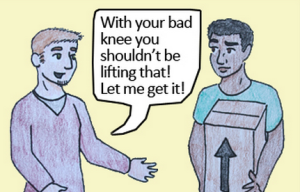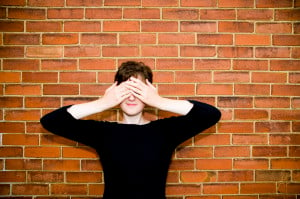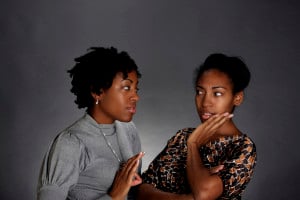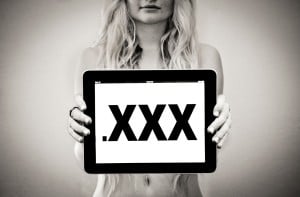
A person wearing a gray beanie and a tank top smiles, their hand resting against their cheek.
Originally published on The Body Is Not an Apology and cross-posted here with their permission.
There is an infinite diversity of genders in the world.
Each person has a totally unique interpretation and relationship with any gender they inhabit, and there are at least as many genders as there have been humans who have lived.
I say “at least” because as it turns out, people can embody more than one gender in their lifetime. We can even embody more than one gender at once. We can experience them as full and independent, or as partial and mixed.
Genders can overlap and negate one another, they can be positive or negative, fixed or in flux, and they can coalesce in any number of combinations.
The idea of having multiple genders is new to many, and downright frightening to some.
It’s time we advanced the mainstream discussion of multigenderism beyond just the absolute basics of “Is it possible?” (Um, yes.)
With that in mind, here are the answers to some basic questions about what it means to be multigender.
1. Is Being Multigender Different From Being Transgender?
No, it isn’t. People who are multigender (or polygender), fall under the umbrella of trans.
Being multigender doesn’t necessarily mean that you will make any physical transition. It also doesn’t necessarily mean that you disidentify with your assigned gender.
Multigender people can identify with – and even present as – their assigned gender, but because they also identify with one or more other genders, they are still included as transgender.
2. Why Is This Distinction Necessary?
It’s necessary because it’s true to life. Many people experience more than one gender, and the fact that they do deserves recognition.
We all have the right to name and define our experiences, to explore and assert our identities without intrusion or manipulation. Finding language that conveys the specifics of our identities is helpful in developing self-understanding, and in communicating our realities to others.
Discovering – or sometimes creating – the best fitting term for you is truly an act of radical self love, and one that diversifies societal perceptions of gender.
3. How Does Multigenderism Relate to the Gender Binary?
Multigenderism is fundamentally anti-binary, whereas the gender binary is singular and exclusivist. Our dominant culture wants us each to conform to a single gender – the gender assigned at birth – and no other.
How multigender identities relates to the genders of male and female depends on the multigender identity in question.
Some multigender identities relate only to the two binary genders, such as androgyne, which means male and female. Others include one binary gender, but not the other.
Yet others include both male and female, along with one or more additional genders. There are also multigender identities that exist totally independent and outside of the gender binary.
4. Can Multigender Identities Include Neutral, Negative, or Partial Genders?
Yes. With the exception of genders that are appropriated from marginalized groups (see below), multigenders can include any type of gender imaginable.
This extends to identities such as agender or neutrois, which refer to having no gender; demigender, which refers to having partial gender; and antigender, which is the opposites of another gender (like antigirl).
5. Is There a Limit to the Number of Genders a Person Can Have?
No. Embracing multigenderism means refusing to limit the ways we can understand ourselves.
A person can have as many genders as they can conceive of, with culturally appropriative identities being the only exceptions (see point #8).
6. What Pronouns Should I Use for Multigender People?
The answer to this is the same as for everyone: Ask, and then use whatever pronouns you’re told to use.
And, specifically, use all of them.
If someone gives you more than one pronoun to use, don’t just pick the one that’s easy for you and ignore the rest. Use them all, and if someone asks you to use one more than the others, do that, too.
A note on gender neutral pronouns: I have noticed a certain trend in group settings that I feel is detrimental to non-binary and multigender people. It happens when openly cis folks introduce themselves with binary pronouns, and with they/them pronouns as well.
Some of these people undoubtedly feel a connection to they/them pronouns, and there’s nothing about being cis that precludes their use. But for others, it seems to be a way of showing support for non-binary genders, or of communicating to the group that they would not be offended if someone referred to them gender neutrally.
First, this doesn’t really need to happen – we should all be okay with gender-neutral pronouns anyway, and this symbolic act is not a substitute for having that conversation.
Second, in most cases, this seems to diminish overall accountability.
Cis people who claim they/them pronouns are often not very diligent about using them, with themselves or with others; and as a result, the group becomes more willing to assume that forgetting a person’s “additional” pronouns is permissible.
Similarly, I sometimes hear cis people respond to the question of pronouns using phrases such as “Whatever works,” “I don’t care,” and “They’re all good.”
Maybe it’s all the same to you, but it isn’t to me, nor to many others. Consider the privilege that goes into being blasé on this topic.
There are people who are too afraid to ever come out as who they are, let alone to assert their multiple identities. Hearing dismissive language just makes it that much harder.
Cis people: Be specific when relaying your pronouns, and don’t intrude on identities that don’t really resonate with you.
7. Are Multigender Identities Static or Fluid?
They can be both. Some multigenders involve multiple gender identities that each do not change. Other multigenders involve moving through single genders one at a time.
Genderfluid is sometimes used this way, though it can also mean moving through different multigenders. A person can go from having multiple genders to a single gender and back again. It’s whatever you feel at the time.
Genders can also be in flux. This is when a person only experiences gender identities very briefly before they change. This is often referred to as genderflux, and it is marked by intense variability.
8. Is Having Multiple Genders Appropriative?
That depends on the specific multigender identity in question. Many genders are culturally specific, including some multigenders.
A prominent example of a culturally specific multigender is the Two-Spirit genders of some North American Indigenous groups. Because it’s impossible to access these genders without being part of a specific cultural context, it’s inappropriate for outsiders to claim any Two-Spirit gender.
Multigender identities can encompass many gender identities at once. If any one of the genders included is culturally appropriated, then the overarching identity also becomes problematic.
Pangender people, in a literal sense, identify as all genders. The problem is that “all genders” includes culturally specific genders that must not be appropriated.
Many pangender folks are sensitive to this, however, and identify only as “all available genders.” Some have even moved away from the term toward the word maxigender (maxi- as in “maximum”).
Outside the realm of culture and ethnicity, some gender identities are exclusive to intersex people, such as intergender.
Other identities are only available to neuroatypical people, such as gendervague. This term that describes being unable to discern their gender due to neurodivergence. Two other examples are autigender and fascigender, which are exclusive to people with autism.
Always look into an identity before claiming it as your own.
9. Are Multigender People Oppressed?
Yes. Being multigender is fundamentally contrary to our society’s hierarchical and exclusivist gender binary.
This means that at the very least, multigender people are oppressed socially and psychologically. Our identities are made invisible; they are trivialized, othered, and dismissed.
We suffer stigmatization, microaggressions, and various forms of body terrorism. The legitimacy of our self-understanding is called into question every day.
The extent to which multigender people are oppressed is highly variable. It is influenced by the matrix of each person’s intersecting identities.
If a multigender person is of color, an immigrant, working class, queer, and/or disabled, they will experience a greater degree of gender-based and binarist oppression than a person with relative privilege.
Additionally, a multigender person’s experience of oppression is affected by factors specific to their gender. Femmegender people, for instance, have an accentuated experience of femmephobia, because they identify with multiple femme genders.
Multigender people who are not able to “pass” for a binary gender commonly experience harassment, as do multigender people who transition physically using hormones and surgeries.
Genderfluid and genderflux people, whose presentation may change from day to day, are often subject to intense social marginalization.
10. What Are Some Other Multigender Identities?
I have been unable to find a comprehensive list of every multigender – although there are some lengthy lists out there – but here are just a few more examples of the multigender identities that have been described in our culture:
- Amorgender – gender that changes in response to a romantic partner’s
- Mirrorgender – gender that changes to reflect those around you
- Ambigender – two genders experienced simultaneously as equal and unchanging
- Chaosgender – gender that is highly unpredictable
- Genderfuck – a subversive gender that can be singular or multi
- Demifluid – having multiple genders where some are fluid, while others are static
- Collgender – not pangender, but having too many genders to describe
- Endogender – having multiple genders that all relate to a specific gender construct, e.g. mascfluid
- Cyclogender – gender that changes with hormonal cycles
- Fissgender – having highly disparate genders, as in “fissured”
- Domgender – having multiple genders where one is dominant over the rest
- Gendervex – having multiple genders, each of which is unidentifiable
***
To learn more about this topic, check out:
- What Is Gender Non-Conforming? Here’s a Great Explanation
- 5 Things You Should Know About Being Genderqueer
- 9 Strategies for Dealing with Gender Dysphoria for Gender Queer and Trans Folks
[do_widget id=’text-101′]
Jenny is a queer, trans Armenian street photographer and artist in the Bay Area who also writes prose and poetry. Follow Jenny on Twitter or Instagram @jennytwojoints.
Search our 3000+ articles!
Read our articles about:
Our online racial justice training
Used by hundreds of universities, non-profits, and businesses.
Click to learn more




















